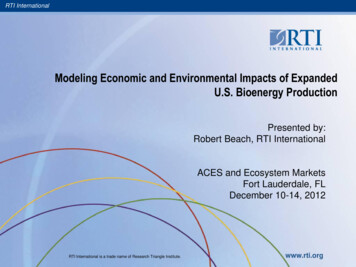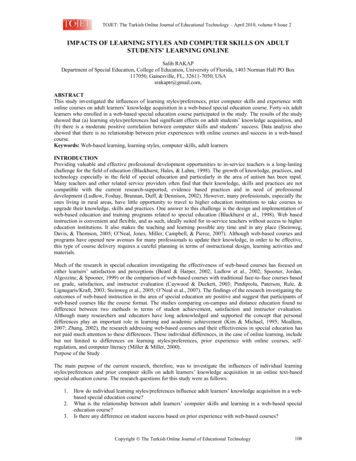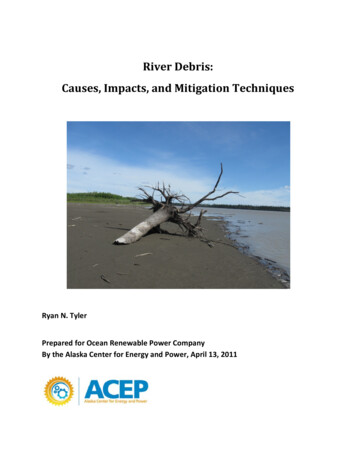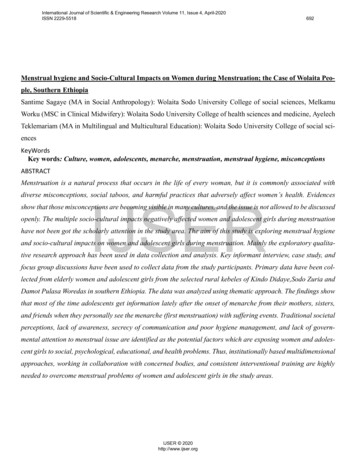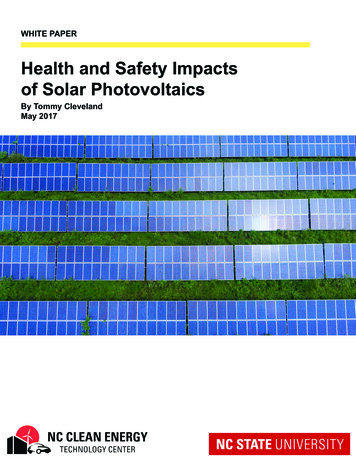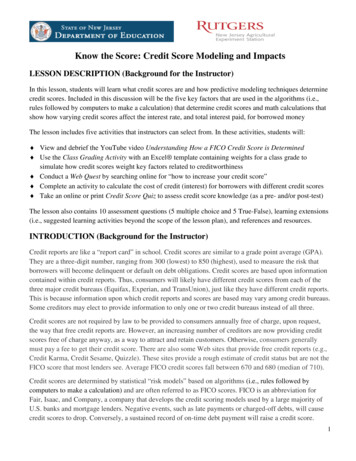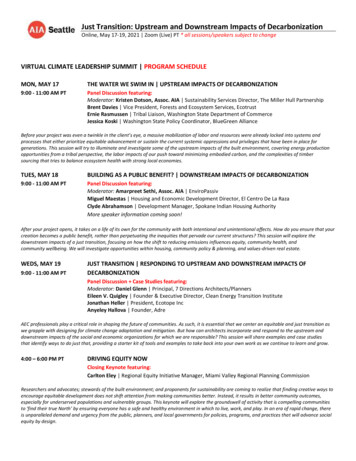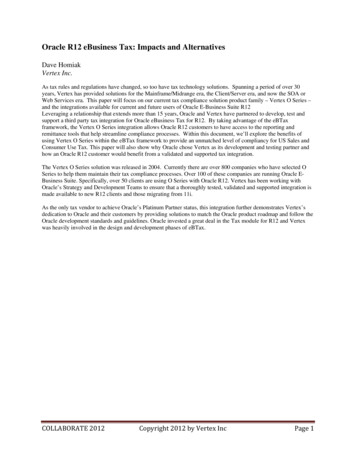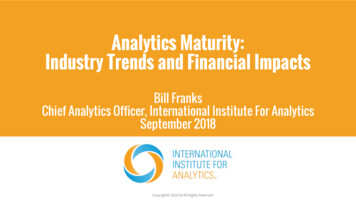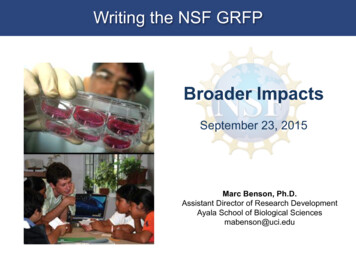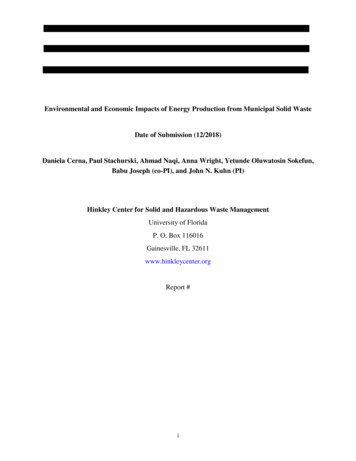
Transcription
Environmental and Economic Impacts of Energy Production from Municipal Solid WasteDate of Submission (12/2018)Daniela Cerna, Paul Stachurski, Ahmad Naqi, Anna Wright, Yetunde Oluwatosin Sokefun,Babu Joseph (co-PI), and John N. Kuhn (PI)Hinkley Center for Solid and Hazardous Waste ManagementUniversity of FloridaP. O. Box 116016Gainesville, FL 32611www.hinkleycenter.orgReport #i
AcknowledgmentsThe authors gratefully acknowledge funding from Hinkley Center for Solid and Hazardous WasteManagement. In addition, financial support from Kuwait Ministry of Higher Education (to AN)and College of Engineering at the University of South Florida is greatly appreciated. We also thankour Technical Awareness Group (TAG) for the time and efforts on this project.ii
Table of ContentsList of Figures . vList of Tables . viList of Abbreviations & Acronyms. viiMetrics. . viiAbstract . .ix1. Introduction And Background . 12. Waste Treatment Options And Economics . 32.1 Anaerobic Digestion Description . 32.1.1. Biogas Production Rate. 32.1.2. Mass Balance on an Anaerobic Digestion System . 52.1.3. Energy Balance on an Anaerobic Digestion System . 52.1.4. Anaerobic Digestion Economics. 62.2. Gasification Process Description . 1222.2.1. Syngas Production Rate . 1222.2.2. Mass Balance on a Gasification System . 1332.2.3. Energy Balance on a Gasification System . 1442.2.4. Gasification Process Economics . 1442.3. Incineration Process Description . 1772.3.1. Material Balance on an Incineration Plant . 1772.3.2. Energy Produced on an Incineration Plant. 182.3.3. Incineration Economics . 183. Biogas Purification Technologies . 203.1. Activated Carbon Beds . 2113.1.1. Capital Expenses . 2223.1.2. Operational Expenses. 2223.2 Iron Sponge Beds . 2223.2.1 Capital Expenses . 2333.2.2 Operational Expenses. 2333.3 Cooler and Blower Units . 2333.3.1 Capital Expenses . 2333.3.2 Operational Expenses. 2334. Energy Recovery Methods . 2444.1 Combined Heat and Power Unit Description. 244iii
4.1.1 Capital Expenses . 2444.1.2 Operational Expenses. 2554.2 Liquid Fuel Production Description. 2554.2.1 Capital Expenses . 2664.2.2 Operational Expenses. 2664.3 Compressed Natural Gas Production Description . 2664.3.1 Capital Expenses . 2774.3.2 Operational Expenses. 2775. Environmental Impact Analysis . 285.1 Carbon Balance on an Anaerobic Digestion System . 295.2 Carbon Balance on a Gasification System . 295.3 Comparison of CO2 emissions . 296. Excel Calculator Description . 2906.1 Input Tab . 3006.2 Output Tab . 3006.3 Report Tab . 3117. Case Study . 3118. Conclusion . 3669. Recommendations . 37710. References .3811. Appendices . 411Appendix A. Default Ultimate and Proximate Analysis for Calculator Feedstock Options. 411Appendix B. Visual Representation of the Tabs in the Excel calculator . 422iv
List of FiguresFigure 1. Anaerobic Digestion Process Flow Diagram describing how waste can undergo AD toproduce biogas and digestate. . 3Figure 2. Fixed capital cost for an AD plant using high moisture feeds such as Animal Manureand WWTP sludge. . 7Figure 3. Fixed capital cost for an AD plant using low moisture feeds such as MSW and yardwaste. . 8Figure 4. Operational Expenses for an AD plant using high moisture feeds like animal manureand WWTP sludge. . 100Figure 5. Operational Expenses for an AD plant using low moisture feeds MSW and yard waste. 100Figure 6. Operational expenses per dry ton for an AD plant using high moisture such as animalmanure and WWTP sludge . 111Figure 7. Operational expenses per dry ton for an AD plant using low moisture feeds. . 111Figure 8. Mass balance inputs and outputs in a gasification system. . 14Figure 9. Capital Expenses of Gasification as a function of plant capacity . 15Figure 10. Operational expenses of a gasification plant in relation to plant capacity in drytons/year. . 17Figure 11. Equation to determine the fixed capital expenses of incineration based on plantcapacity . 19Figure 12. Equation to determine the operational expenses of incineration based on plantcapacity. . 20Figure 13. Equation to determine the fixed capital expenses of a combined heat and powerfacility as a function of power production . 25Figure 14. Fixed capital expenses of CNG production through PSA as a function of plantcapacity . 27Figure 15. Operational expenses of CNG production through PSA as a function of plant capacity. 28Figure 16. Discounted cumulative cash flow diagram for an incineration and CHP plant with alife span of 25 years. . 33Figure 17. Discounted cumulative cash flow diagram for an anaerobic digestion and CHP plantwith a life span of 25 years. . 35v
List of TablesTable 1. Economic and Environmental Advantages and Disadvantages of Waste to EnergyTechnologies . 2Table 2. Variables for Feed Chemical Formula Derived from Dry Basis Mass Ultimate Analysisof the Feed. 4Table 3. Fixed Capital Cost Data for Different Plant Capacities for High Moisture Feeds . 6Table 4. Fixed capital cost for an AD plant using high moisture feeds such as Animal Manureand WWTP sludge. . 8Table 5. Operational Expense Data for Different Plant Capacities for High Moisture Feeds . 9Table 6. Operational Expense Data for Different Plant Capacities for Low Moisture Feeds . 9Table 7. Fixed Capital Expense Data for Different Plant Capacities for Gasification . 15Table 8. Operational Expenses for Gasification Plants at Different Capacities . 16Table 9. Economic Data for Fixed Capital Expenses of Incineration Plants . 18Table 10. Economic Data for Operational Expenses of Incineration Plants. 19Table 11. Purity Requirements for Energy Recovery Technologies . 21Table 12. Adsorption Capacities of the Beds. 21Table 13. Cost of Bed Materials . 21Table 14. Average Concentration of Siloxanes in Different Feed Types . 22Table 15. Comparison of CO2 Emissions for Various Waste Treatment Methods . 30Table 16. Comparison of CH4 Emissions for Various Waste Treatment Methods . 30Table 17. Economic Report for Incineration and CHP Plant. 32Table 18. Economic Report for Anaerobic Digestion and CHP Plant . 34Table 19. Economic Report for Waste to Energy Plant Treating 365,000 dry tons/yr of MSW . 36vi
List of Abbreviations & Acronymsi.Municipal Solid WasteMSWii.Anaerobic DigestionADiii.Landfill GasLFGiv.Combined heat and power unitsv.Fischer-Tropsch Synthesisvi.Compressed Natural GasCNGvii.Greenhouse GasGHGviii.Waste to EnergyWtEix.Nitrogen, Phosphorus, and PotassiumNPKx.Chemical Engineering Plant Cost Indexxi.Activated Carbonxii.Waste Water Treatment Plantxiii.Net Present WorthNPWxiv.Waste to EnergyWtExvPressure Swing AdsorptionPSACHPFTSCEPCIACWWTPvii
FINAL REPORT12/1/17 to 11/30/18PROJECT TITLE: Environmental and Economic Impacts of Energy Production fromMunicipal Solid WastePIs: John N. Kuhn (jnkuhn@usf.edu; 813 974 6498) & Babu Joseph (bjoseph@usf.edu; 813974 0692)AFFILIATION: Department of Chemical & Biomedical Engineering,University of South FloridaPROJECT WEBSITE: http://www.eng.usf.edu/ jnkuhn/Hinkley2017.htmlCOMPLETION DATE: 1/31/2019TAG MEMBERS:John SchertDirectorHinkley CenterWester W. HendersonResearch CoordinatorDevin WalkerProcess EngineerT2C-EnergyMatt YungResearcherNat. Renewable Energy LabIIITim RobergeHinkley CenterT2C-EnergyRichard K MeyersSWRS Program ManagerBroward County Solid Wasteand Recycling ServicesLee CaseyChief of Environ. Compliance(Retired)Miami Dade County Dept ofSolid WasteCanan “Janan” BalabanAsst. DirectorFlorida Energy SystemsConsortiumRon BeladiVice-presidentNeel-Schaffer, Inc.Rebecca RodriguezEngineer Manager IILee County Solid WasteDivisionviii
Linda MonroyProject Manager AssociateLee County Solid WasteDivisionSam LevinPresidentS2LICharles “Peb” HendrixChief Operating OfficerLocatorXTony ElwellStaff Engineer IHSW Engineering, IncNada ElsayedScientist, PDCatalent Pharma Solutions IncYolanda DazaProcess TD EngineerIntel CorporationJames FlyntChief EngineerOrange County UtilitiesDepartmentGita IranipourEngineer AssociateHillsborough County PublicUtilities DepartmentLuke MulfordWater Quality ManagerHillsborough County PublicUtilities DepartmentRay OatesSolid Waste ComplianceManagerCitrus County Division of SolidWaste ManagementABSTRACTThe average amount of waste generated in the United States is 4.4 lb/day/person, and the vastmajority of it is landfilled. The enormous amount of energy contained in these wastes presents anopportunity for renewable energy production. Comparison and analysis of energy productionmethods in terms of economic and environmental impacts are needed to make best use ofresources. Therefore, it is crucial to implement waste to energy technologies when advantageousto reduce landfilling, to generate profit, and to minimize environmental impact.Municipal Solid Waste (MSW) can undergo processes like Anaerobic Digestion (AD),Incineration or Gasification to produce biogas or syngas. In addition, gases produced in landfills(Landfill Gas or LFG) can be used as an energy source as well. These gases can be purified andupgraded to be used in energy recovery methods such as combined heat and power units (CHP),Fischer-Tropsch Synthesis (FTS) for the production of liquid fuels, or the production ofCompressed Natural Gas (CNG). These technologies are emerging and minimal data has beenreported for the operation of these plants. A limitation encountered when trying to implement andbuild one of these plants is that there is no set tool that compiles and analyses the techno-economicdata of the existing plants and can provide fast cost estimation for the screening of these alternativeprojects. The goal of this research is to create a software tool based in Excel to assist decisionmakers such as municipalities and waste management companies. Using this tool, the user is ableto select the technology desired: AD, Gasification, Incineration or Landfilling, as well as theenergy recovery method: CHP, liquid fuel or CNG production. The user will also provide thefeedstock type (Municipal Solid Waste (MSW), Food Waste, Animal Manure, and Farm Waste),feed properties and plant capacity. The software tool is set to provide the user with the capital andoperational cost requirements, biogas production rate and its composition, and where applicable,ix
liquid and solid production rates. The calculator also includes the cost of biogas purification basedon the purity requirements for each energy recovery technique.The use of the tool is illustrated using a base case AD plant that will generate biogas that will beused to produce liquid fuels via FTS. The plant processes 60,000 dry tons/year of MSW with amoisture content of 30%. Using the calculator, the capital cost of the AD plant is computed at 21.0 million and the operational expenses at 1.7 million /year. The capital cost associated withpurifying the biogas up to liquid fuel production standards is 500,000 and the operationalexpenses are 163,000/year. The software tool provides the user with the ability to compare andcontrast alternative waste-to-energy options and incentivize building these plants.Disclaimer: While we have attempted to get the best estimates possible for the costs involved, theresults should be considered as preliminary estimates only and actual costs can vary substantiallydepending on the feed types and specific technologies used.KEYWORDS: Municipal Solid Waste (MSW); Energy Recovery; Material Recovery; Waste-toEnergy (WtE); Support Tool,METRICS:1. List graduate or postdoctoral researchers funded by THIS Hinkley Center okefunPhD studentChemicalEngineeringKuhn/JosephUSFNaqi, AhmadMS studentChemicalEngineeringKuhn/JosephUSF2. List undergraduate researchers working on THIS Hinkley Center project.NameDept.InstitutionProfessorStachurski, PaulChemical EngineeringUSFKuhn/JosephCerna, DanielaChemical EngineeringUSFKuhn/JosephKastelic, MatthewChemical EngineeringUSFKuhn/JosephWright, AnnaChemical EngineeringUSFKuhn/Joseph3. List research publications resulting from THIS Hinkley Center projects.x
Naqi, A., Kuhn, J.N., and Joseph, B., “Techno-economic Analysis of Producing Liquid Fuels fromBiomass via Anaerobic Digestion and Thermochemical Conversion” submitted.Cerna, Daniela, “Economic and Environmental Analysis of Waste-to-Energy TechnologiesProcessing Urban and Rural Waste” (2018). Honor’s Thesis, Chemical and BiomedicalEngineering, USF, Tampa.Naqi, Ahmad, "Conversion of Biomass to Liquid Hydrocarbon Fuels via Anaerobic Digestion: AFeasibility Study" (2018). M.S. Thesis, Chemical and Biomedical Engineering, USF, Tampa.Stachurski, Paul, “An Investigation of Technologies for Energy Recovery from Municipal
feedstock type (Municipal Solid Waste (MSW), Food Waste, Animal Manure, and Farm Waste), feed properties and plant capacity. The software tool is set to provide the user with the capital and operational cost requirements, biogas p
